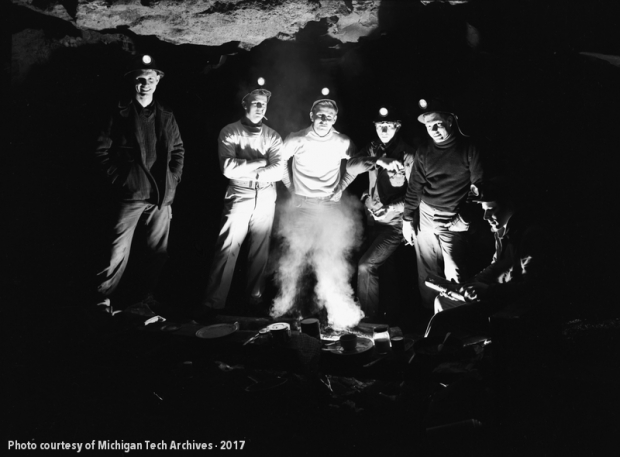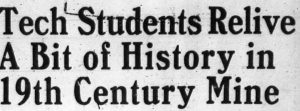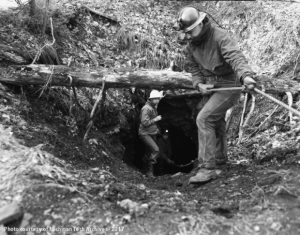
Happy Flashback Friday! We hope that you all had a howling good time at the Haunted Mine tour put on by students at Michigan Tech and hosted by the Quincy Mine Hoist Association! Undoubtedly, the deep, dark recesses of a mine like Quincy is the perfect backdrop for a fright fest and a great opportunity to get a sense of what life in the mines was like. Can you imagine what it was like to be a miner? What sights or sounds do you think you’d see an hear?
Anyone who has taken the tour up at Quincy has heard of Michigan Tech’s longstanding relationship with the mine, which once served as a learning facility for mining engineers, giving students hands on experience in what it was like to work underground. However, what you might not have heard is the true story about how some ambitious Tech students got a once in a lifetime opportunity to actually work like miners and resurrect a piece of Copper Country history in the process. Take a drive up the Keweenaw with us this Flashback Friday and learn more about how a bunch of Tech students raised a historic hoist from the depths of the Copper Falls Mine in 1954!

The Copper Falls Mine was established near Owls Creek in Keweenaw County in the 1840s at the site of a prehistoric mining pit. The mine operated for over 40 years and produced, according to a Daily Mining Gazette article from 1956, “12,843 tons of ingot copper,” and employed “mostly Cornish, Finnish, and Irish” workers until its closure in 1901. The old hoist at the Copper Falls Mine was located by Michigan Tech geology student Robert “Speed” Burns in the early 1950s and eventually he and Dr. Joseph P. Dobell, geology professor at Michigan Tech, proposed a project to remove the 11-ton steam hoist. The Calumet and Hecla Mining Company, which then owned the property on which the hoist resided, agreed to the project following a safety inspection. The company also supported the project through the donation of safety equipment such as hard hats and headlamps.

Over the course of 8 months from October 1954 to spring 1955, students from the Sigma Rho Fraternity lived the life of miners working to remove the 19th century hoist from its placement eight and a half levels (nearly 900 feet) below the surface. According to a DMG article about the project, access was made through an “air ventilation adit that intersected the main Owls Creek shaft at the second level.” However, the students faced two big problems: no skip, and the need to lay 600 feet of track. Ingenious Tech students that they were, the Sigma Rho students constructed a skip with wheels out of scraps found at the site and laid the 600 feet of track themselves after backbreaking work that involved filling in washouts, erecting trestles, and replacing rotten ties.

Despite battling the mile and a half trudge from the highway through snow to reach the work site and eventually combating rising waters in the subterranean levels of the mine during the spring melt, the students had risen the ancient hoist above ground in its near entirety by spring. Miraculously, not a single person was injured throughout the project and only a few pieces of equipment were lost or damaged. What the students were left with, beyond the prize of the hoist itself, was an invaluable hands on experience of “mining out” the old hoist from the depths of a historic mine.
So what become of the hoist itself? The Daily Mining Gazette article from 1956 merely states that at that time the Sigma Rho Fraternity was waiting for an offer from the “college or any group interested in having it for display purposes.” Do you know what became of the hoist? Share your story here!
If as restored and is displayed outdid the fraternity’ s house